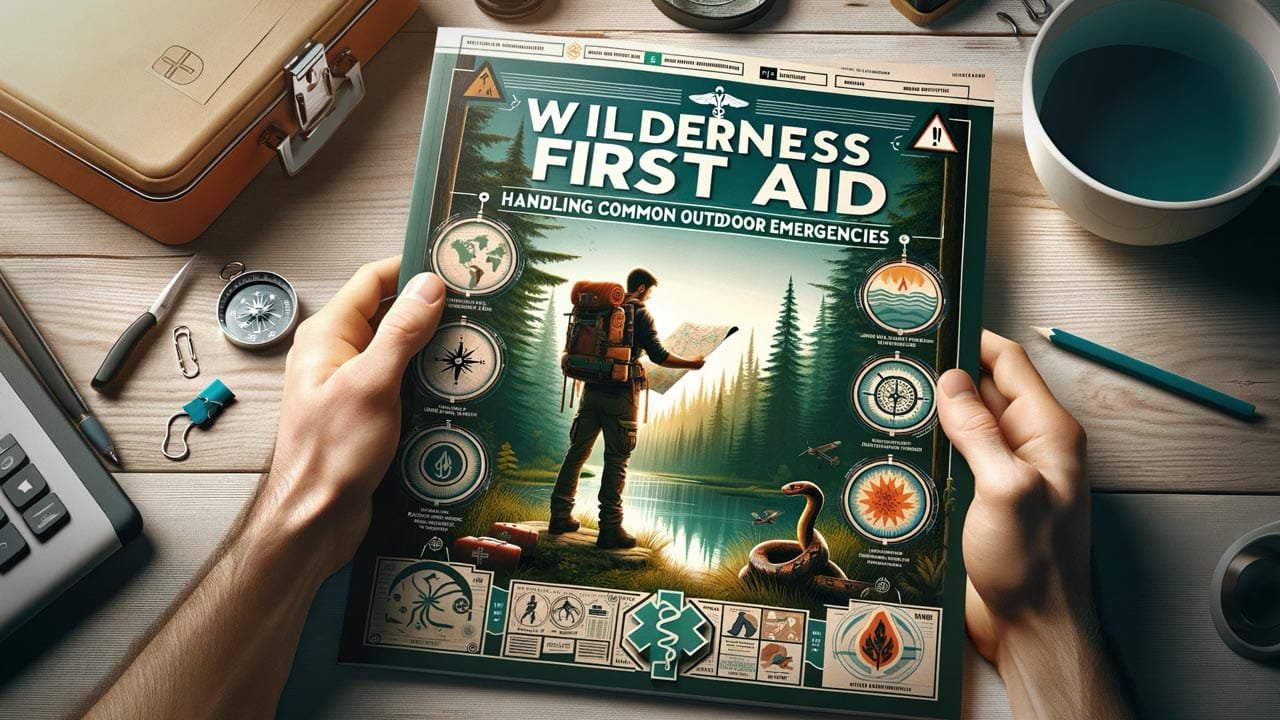Wilderness First Aid: Handling Common Outdoor Emergencies
Wilderness First Aid, Exploring the great outdoors is accompanied by inherent risks. From minor injuries like cuts and sprains to severe conditions such as hypothermia, being prepared is crucial. This article delves into essential wilderness first aid techniques, equipping you with the knowledge to handle common outdoor emergencies.
Key Takeaways
- Understand the basics of wilderness first aid.
- Learn how to respond to common injuries and emergencies.
- Discover essential items for your wilderness first aid kit.
Table of Contents
- Introduction to Wilderness Emergencies
- Understanding Basic First Aid Principles
- Common Wilderness Emergencies
- First Aid Techniques for Common Wilderness Injuries
- Wilderness First Aid Kit Essentials
- Managing Animal and Insect Bites
- Dealing with Temperature-Related Emergencies
- Conclusion: The Importance of Preparedness
- Frequently Asked Questions
- Additional Resources
Introduction to Wilderness Emergencies
Adventuring into the wilderness is an exhilarating experience that connects us with nature, but it also brings a set of unique challenges and risks. The wilderness, with its remote and often unpredictable environment, requires a level of preparedness and awareness that goes beyond the usual.
Why Understanding Wilderness Emergencies is Crucial
- Unexpected Situations: In the wilderness, emergencies can arise suddenly and unexpectedly, ranging from minor mishaps to life-threatening situations.
- Remote Locations: Often far from immediate medical help, these emergencies demand a self-reliant approach.
- Diverse Challenges: Challenges include natural hazards, wildlife encounters, and weather extremes, all of which can turn a routine trip into a critical situation.
Common Types of Wilderness Emergencies
- Injuries: Falls, cuts, and fractures are common due to the rugged terrain.
- Environmental Hazards: Exposure to extreme temperatures, resulting in heatstroke or hypothermia.
- Wildlife Encounters: From insect bites to dangerous animal interactions.
- Getting Lost: Misjudging routes or losing navigation tools can lead to disorientation.
The Unpredictability of Nature
- Changing Weather: Sudden weather changes can escalate the risk of hypothermia or heat-related illnesses.
- Terrain Challenges: Unstable grounds, river crossings, and rocky paths can lead to physical injuries.
- Limited Communication: Often, cellular signals are weak or non-existent, complicating rescue efforts.
The Role of Preparedness
- Mental Readiness: Understanding potential risks and mentally preparing for emergencies is as important as physical readiness.
- Skill Development: Learning basic survival skills, first aid, and navigation techniques can make a significant difference in handling emergencies.
- Equipment: Carrying the right equipment, including a well-stocked first aid kit, appropriate clothing, and communication devices, is essential.
Understanding wilderness emergencies is about respecting the unpredictable nature of the outdoors and equipping oneself with the knowledge and tools to safely enjoy and survive in these environments.
Understanding Basic First Aid Principles
Effective first aid in the wilderness begins with a solid understanding of basic principles. These principles are not just about treating injuries but about making informed decisions in challenging environments.
Assessing the Situation
- Initial Evaluation: When an emergency arises, the first step is to evaluate the safety of the scene for both the injured person and the responder.
- Identifying Injuries: Quickly identify the type and severity of injuries. This includes checking for responsiveness, breathing, and any visible injuries.
- Environmental Factors: Consider environmental factors that could impact the situation, such as weather conditions, terrain, and the possibility of further hazards.
Prioritizing Injuries
- Life-Threatening Conditions: Give immediate attention to life-threatening conditions like severe bleeding, breathing difficulties, or signs of shock.
- Secondary Injuries: Once critical conditions are stabilized, assess and treat secondary injuries like sprains, fractures, or minor cuts.
- Comfort Measures: In addition to treating injuries, it’s important to provide comfort and reassurance to the injured person, helping to reduce panic and anxiety.
Knowing When to Seek Professional Help
- Judging Severity: Recognize when an injury or illness is beyond your capacity to treat and requires professional medical attention.
- Evacuation Decision: In some cases, evacuation may be necessary. Assess the need for evacuation based on injury severity, weather conditions, and the distance from medical facilities.
- Communication Strategies: Understand how to send distress signals or communicate with rescue teams, especially in areas with limited cellular coverage.
First Aid Kit Usage
- Familiarity with Contents: Know your first aid kit’s contents and how to use each item effectively.
- Regular Checks: Regularly check and replenish your kit to ensure all items are functional and within their expiration dates.
Psychological First Aid
- Emotional Support: Providing emotional support is crucial. Encourage a positive outlook, which can significantly impact the injured person’s ability to cope with the situation.
- Managing Stress: Learn techniques to manage stress and make clear decisions, as panic can impair judgment and exacerbate the situation.
Understanding these basic first aid principles is essential for anyone venturing into the wilderness. It’s not only about having the right supplies but also about possessing the knowledge and confidence to use them effectively in any situation.
Common Wilderness Emergencies
The wilderness is a dynamic environment where various emergencies can occur. Being aware of the most common types of emergencies helps in preparing adequately and responding effectively.

Types of Injuries and Conditions
- Falls and Traumas: Due to uneven terrain, slips and falls are common. These can result in sprains, fractures, or more severe injuries like concussions or spinal damage.
- Cuts and Lacerations: Encountering sharp objects or rough vegetation can lead to cuts. Deep lacerations require immediate attention to control bleeding and prevent infection.
- Animal and Insect Bites: Encounters with wildlife, from minor insect bites to potentially dangerous animal attacks, can occur. Some may require immediate medical attention, especially in cases of allergic reactions or venomous bites.
- Plant-Related Injuries: Contact with poisonous plants can cause reactions ranging from mild irritation to severe allergic responses.
Environmental Hazards
- Hypothermia: Exposure to cold, especially in wet conditions, can lead to hypothermia. Recognizing early symptoms like shivering and numbness is crucial for timely intervention.
- Heat-Related Illnesses: In hot climates, heat exhaustion and heatstroke are risks. Symptoms include dizziness, headache, and in severe cases, confusion or loss of consciousness.
- Altitude Sickness: At high elevations, altitude sickness can occur, characterized by headache, nausea, and fatigue. It requires prompt descent to lower altitudes and medical care.
- Dehydration and Malnutrition: Limited access to clean water and adequate food can lead to dehydration and malnutrition, impacting physical and cognitive abilities.
Navigational Challenges
- Getting Lost: Losing one’s way is a common issue. It can lead to panic, further disorientation, and additional dangers like exposure and dehydration.
- Water Hazards: Crossing rivers or streams can be risky, leading to injuries or dangerous situations like being swept away by strong currents.
Psychological Stress
- Fear and Anxiety: The stress of facing an emergency can lead to fear and anxiety, impacting decision-making abilities.
- Group Dynamics: Managing group dynamics and maintaining morale is vital, especially in prolonged or complex emergency situations.
Being familiar with these common wilderness emergencies and their immediate first aid responses is crucial for anyone venturing into remote areas. Preparedness, both in terms of knowledge and equipment, is key to effectively managing these situations and ensuring safety.
First Aid Techniques for Common Wilderness Injuries
Effective first aid in the wilderness is crucial for managing injuries and preventing complications. Here are detailed techniques for handling the most common injuries encountered in outdoor environments.
Treating Cuts and Scrapes
- Initial Care: Clean the wound with clean water. If available, use antiseptic wipes to disinfect the area.
- Stopping Bleeding: Apply gentle pressure with a clean cloth or sterile gauze to stop bleeding.
- Bandaging: Once bleeding is controlled, cover the wound with a sterile bandage or dressing.
- Monitoring: Keep an eye on the wound for signs of infection, such as redness, swelling, or pus.
Handling Sprains and Strains
- R.I.C.E Method: Rest the injured limb, apply Ice to reduce swelling, use a Compression bandage, and Elevate the limb above the heart level.
- Immobilization: Avoid using the injured area to prevent further damage.
- Assessment: If pain and swelling don’t decrease, seek professional medical help.
Managing Fractures
- Immobilization: Use a splint to immobilize the affected area. This can be made from rigid materials like sticks, padded with soft materials.
- Avoid Movement: Ensure the injured person remains as still as possible.
- Seek Help: Fractures often require professional medical treatment, especially if there’s a risk of bone misalignment or puncturing the skin.
Dealing with Insect Bites and Stings
- Immediate Action: Remove the stinger if visible. Avoid squeezing it, which can inject more venom.
- Cleaning: Clean the area with soap and water.
- Reducing Swelling: Apply a cold pack or a cool, damp cloth to the area.
- Monitoring Symptoms: Watch for signs of an allergic reaction, such as difficulty breathing, swelling of the face or throat, which require immediate medical attention.
Treating Hypothermia and Heat Exhaustion
- Hypothermia: Remove any wet clothing and replace with dry, warm layers. Use blankets or body heat to warm the person. Provide warm, non-alcoholic beverages if the person is conscious.
- Heat Exhaustion: Move the person to a cooler place, apply cool, wet cloths, and provide sips of water if they are conscious.
Addressing Burns
- Cool the Burn: Use cool water, not ice, to cool the burn for 10-20 minutes.
- Covering: Apply a sterile, non-adhesive bandage or clean cloth.
- Avoiding Home Remedies: Don’t apply ice, butter, or creams, which can cause more damage.
- Medical Attention: Seek professional help for severe burns.
Wilderness First Aid Kit Essentials
A comprehensive wilderness first aid kit is a fundamental component of any outdoor adventure. It should be tailored to the specific needs of the trip and the individuals involved. Here’s a detailed breakdown of the essentials for a well-prepared kit.
Basic Supplies
- Adhesive Bandages: Various sizes for small cuts and blisters.
- Sterile Gauze Pads: For covering and protecting larger wounds.
- Antiseptic Wipes: To disinfect wounds before dressing.
- Medical Adhesive Tape: For securing dressings and splints.
- Tweezers and Scissors: For removing debris and cutting dressings.
- Safety Pins: Useful for securing bandages and makeshift repairs.
- Digital Thermometer: To monitor body temperature.
- Disposable Gloves: To maintain hygiene and prevent infection transfer.
Medications
- Pain Relievers: Such as ibuprofen or acetaminophen for pain and fever.
- Antihistamines: For allergic reactions.
- Anti-Diarrheal Medication: To manage symptoms of diarrhea.
- Electrolyte Tablets: For dehydration prevention and treatment.
Wound Care and Closure
- Butterfly Bandages and Steri-Strips: For closing small wounds.
- Liquid Bandage: To seal minor cuts and scrapes.
- Moleskin: For blister prevention and care.
Advanced Care Items
- SAM Splint: For immobilizing fractures or sprains.
- Elastic Bandage: For sprains and strains.
- Emergency Blanket: For warmth or shock treatment.
- CPR Face Shield: For safe mouth-to-mouth resuscitation.
- Irrigation Syringe: To clean wounds effectively.
- Hemostatic Gauze: For controlling severe bleeding.
- Tourniquet: For life-threatening bleeding (as a last resort).
- Israeli Bandage: A versatile tool for bleeding control.
- Chest Seal: For treating open chest wounds.
Survival and Signaling Tools
- Whistle: For signaling distress.
- Signal Mirror: For visual signaling.
- Compass: For navigation.
- Paracord: Versatile for various uses, including medical applications.
- Emergency Fire Starter: For warmth and emergency signals.
Personal Items
- Prescription Medications: Clearly labeled and in original containers.
- Epinephrine Autoinjector (EpiPen): For severe allergic reactions.
- Spare Glasses or Contacts: If vision correction is required.
- Inhalers: For asthma or respiratory conditions.
- Insulin or Glucose Gel: For diabetes management.
Training and Knowledge
- First Aid Manual: For reference in emergencies.
- Knowledge of Kit Contents: Familiarize yourself with the use of each item.
- Regular Kit Checks: Ensure items are within their use-by dates and fully functional.
Having these items in your wilderness first aid kit ensures you are prepared to handle a wide range of emergencies. However, the contents should be adapted based on the length of your trip, the environment, and any specific medical needs of your group.
Managing Animal and Insect Bites
Encounters with wildlife, including various animals and insects, are a common aspect of wilderness adventures. Knowing how to manage bites and stings is crucial for reducing discomfort and preventing serious complications.
Handling Minor Bites and Stings
- Immediate Care: Wash the area with soap and water. This helps prevent infection and reduces irritation.
- Cold Compress: Apply a cold pack or a cloth dampened with cold water to reduce swelling and ease pain.
- Topical Creams: Use hydrocortisone cream or calamine lotion to relieve itching and discomfort.
- Monitoring: Watch for signs of infection, such as increased pain, redness, swelling, or pus.
Responding to Venomous Bites
- Identifying the Culprit: If bitten by a snake or spider, try to remember its appearance for identification purposes.
- Staying Calm: Keep the bitten person calm and still. Movement can cause the venom to spread more quickly through the body.
- Positioning: Keep the affected area at or below heart level to slow the spread of venom.
- Seeking Immediate Help: For venomous bites, especially from snakes, immediate medical attention is crucial.
- Avoiding Incorrect Measures: Do not cut the bite area, try to suck out the venom, or apply a tourniquet.
Dealing with Severe Reactions
- Anaphylaxis Signs: Difficulty breathing, swelling of the face, lips, or throat, and rapid heartbeat are signs of a severe allergic reaction.
- Immediate Action: If an epinephrine autoinjector (EpiPen) is available and the person has a history of severe reactions, use it immediately.
- Emergency Services: Call for emergency medical help without delay.
Preventing Bites and Stings
- Protective Clothing: Wear long sleeves, pants, and closed-toe shoes to minimize skin exposure.
- Insect Repellents: Apply insect repellent to exposed skin and clothing.
- Awareness: Stay alert and avoid disturbing animals or walking through dense underbrush where snakes or other creatures may be hidden.
Aftercare and Follow-Up
- Monitoring: Continue to monitor the bite or sting site for several days for any signs of worsening or infection.
- Medical Follow-Up: If symptoms persist or worsen, seek medical attention.
Animal and insect bites in the wilderness range from minor annoyances to potentially life-threatening emergencies. Prompt and appropriate first aid can significantly mitigate the effects and prevent complications.

Dealing with Temperature-Related Emergencies
Temperature extremes in the wilderness can lead to serious health emergencies. Understanding how to respond to hypothermia and heatstroke is critical for outdoor safety.
Managing Hypothermia
- Early Recognition: Be aware of hypothermia signs, including uncontrollable shivering, slurred speech, and clumsiness.
- Immediate Action: Move the person to a sheltered area. Remove any wet clothing and replace it with dry, warm layers.
- Warming Techniques: Use body heat, warm blankets, or heated water bottles placed in the armpit and groin areas. Avoid direct heat, which can damage the skin or cause irregular heart rhythms.
- Warm Liquids: If the person is conscious, provide warm, sweet, non-alcoholic beverages to aid in warming the body.
- Seek Medical Help: Hypothermia is a medical emergency that requires professional treatment, especially in severe cases.
Treating Heatstroke
- Recognizing Symptoms: Look for signs of heatstroke, such as high body temperature, lack of sweat, confusion, or loss of consciousness.
- Rapid Cooling: Move the person to a cooler place. Apply cool, wet cloths to the skin, and fan the person to promote evaporative cooling.
- Hydration: If conscious and able to swallow, provide cool water or sports drinks to rehydrate.
- Urgent Care: Heatstroke is a severe condition requiring immediate medical attention to prevent organ damage.
Preventing Temperature-Related Emergencies
- Proper Clothing: Wear appropriate clothing for the conditions. Dress in layers to adjust to changing temperatures.
- Staying Hydrated: Drink plenty of fluids in hot conditions, and avoid alcohol and caffeine, which can lead to dehydration.
- Planning and Awareness: Know the weather forecast and plan activities accordingly. Take frequent breaks in shaded areas on hot days.
- Acclimatization: Give your body time to adapt to extreme temperatures, especially when traveling to a different climate zone.
Aftercare
- Monitoring: Continue monitoring the person even after initial treatment. Symptoms can recur or worsen.
- Medical Follow-Up: Ensure a follow-up with a healthcare provider after a severe temperature-related emergency.
Temperature-related emergencies in the wilderness can escalate quickly. Prompt recognition and appropriate first aid intervention are vital for the safety and well-being of anyone experiencing these conditions.
Conclusion: The Importance of Preparedness
The conclusion we draw from wilderness first aid is clear: preparedness is not just about having the right gear and skills; it’s about cultivating a mindset of readiness, continuous learning, and adaptability. Being well-prepared ensures that your wilderness adventures are not only enjoyable but also safe.







Leave A Comment